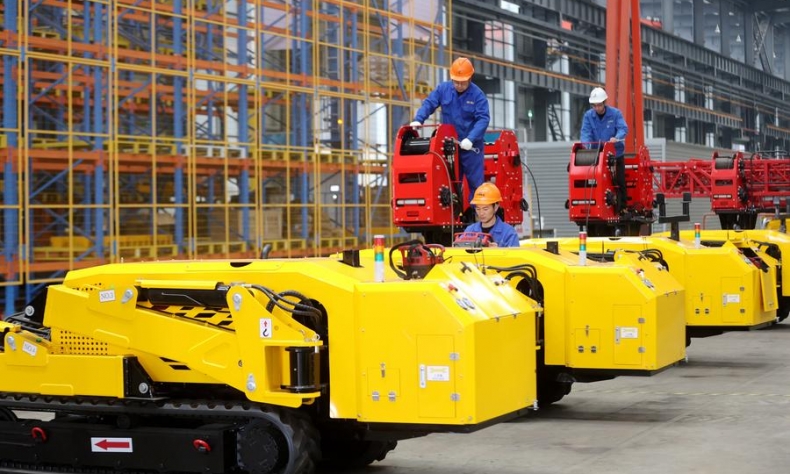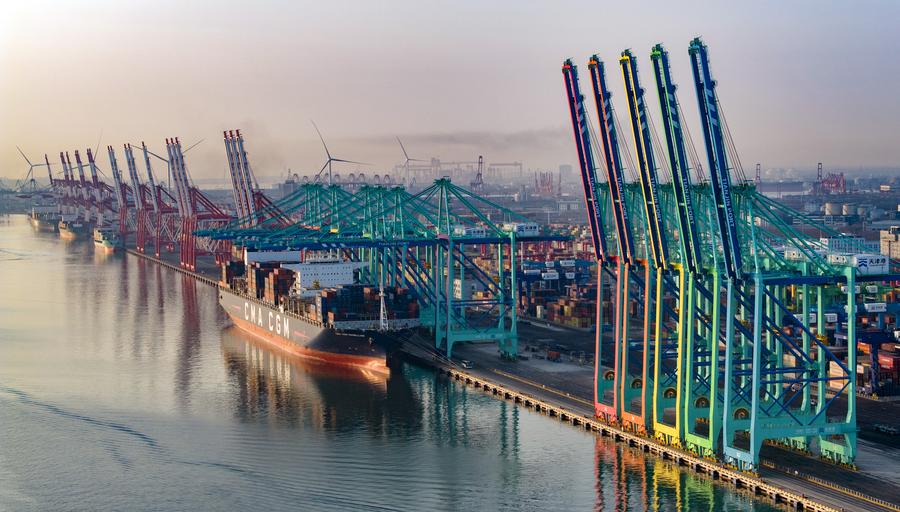Chinese Economy: Changes and Consistencies

China shares the dividends of its development with the rest of the world, plays its due role as a responsible major country, and hence brings more certainty and positive energy into an increasingly turbulent world.
As an important window into China’s economic policy direction, the significance of the “two sessions” becomes even more prominent in a time of increasing geopolitical tension. While the Trump administration is sending daily shockwaves across the world, fueling uncertainties, deep-seated domestic structural problems are becoming more pronounced, ramping up downward pressure on the Chinese economy.
The “two sessions” offered insights into how the world’s second-largest economy will proactively identify, respond to, and steer changes, navigate the opportunities and challenges arising from competition among major countries. Moreover, a scientific and technological revolution, economic transformation, and social governance will help push Chinese modernization.
In the government work report delivered at the third session of the 14th National People’s Congress (NPC) on March 5, Chinese Premier Li Qiang reviewed China’s economic and social development in the past year and set out the work schedule going forward.
What are the changes ahead?
After highlighting China’s achievements in seven sectors over the past year, the report sets the development goals and policy orientation for 2025, with priority given to 10 tasks. A range of concepts such as “embodied AI,” “6G technology,” “unicorn companies,” “zero-based budgeting reform,” “new types of offshore trade,” and “adjusting or reducing property transaction restrictions” hold the key to understanding China’s pursuit of high-quality economic development and the thinking behind its macro policies.
Industrial structure has been updated. China has made solid headway in fostering new quality productive forces and enhancing its innovation capacity, as proved by its achievements in integrated circuits, artificial intelligence, and quantum technology among other sectors. “Intelligent manufacturing in China” is no longer a novelty in financial and tech circles. It has now captivated the interest of ordinary citizens and global markets with the many transformative events in this field over the past year.
Last year, China’s output of new-energy vehicles passed the 13-million mark, propelling the global auto industry into an era where innovation is in the driving seat. China’s chip exports surpassed RMB one trillion. And its sixth-generation fighter jet successfully completed test flights.
In the eternal search for cutting-edge technology, at the beginning of 2025, the world was introduced to the Chinese startup DeepSeek, which unveiled its DeepSeek R1 large AI model, with its exceptional cost efficiency and cutting-edge architectural innovations. It smashed the capital bubble and computational barriers created by the U.S. tech industry. In the field of humanoid robotics, this year’s Spring Festival Gala featured robot dancers manufactured by Unitree, showing off their moves alongside a human troupe.

According to some foreign researchers, China’s hi-tech sector has come to a “Sputnik moment,” and its innovation ability is igniting a global reassessment of Chinese enterprises’ development potential and asset prices. Among the 10 major tasks for 2025 one is developing new quality productive forces in light of local conditions and accelerating the development of a modernized industrial system, while another is implementing the strategy of invigorating China through science and education, and boosting the overall performance of China’s innovation system. This underscores China’s confidence and policy direction to lead the next wave of technological and industrial revolution.
Risk awareness grows stronger. While acknowledging achievements, the report provides a sober, objective assessment of the challenges and problems China faces. The U.S. is a major external threat to the Chinese economy. By the time the “two sessions” opened, President Donald Trump, in office for just over a month, had announced an overall 20 percent tariff increase on Chinese goods and launched trade investigations and investment restrictions across multiple sectors.
Domestically, the foundation of China’s sustained economic recovery and growth is not strong enough. For example, consumption remains sluggish, and risks persist in key areas such as real estate, local government debt, and the financial sector. The government is taking action to address these problems. Boosting consumption is listed as its first major task in 2025. Another priority is “effectively preventing and defusing risks in key areas and ensuring that no systemic risks arise.” For the first time, “ensuring stability in the real estate market and the stock market” has been included among the overall requirements and policy orientations for China’s economic and social development.
China will roll out more measures to expand higher-standard opening up and stabilize foreign trade and investment. It will also expand the functions of overseas economic and trade cooperation zones, develop new types of offshore trade, and explore other innovative measures to navigate the dramatic changes in international economic and trade landscape.
This is accompanied by a shift in macroeconomic policy. As the government work report says, “Policies should be introduced and implemented as soon as possible – it is better to act early than late, as this will buy valuable time for addressing any uncertainties that may arise. When a clear direction is identified, action should be decisive to pull all necessary resources to ensure more effective outcomes.” This statement shows the great emphasis the Chinese government puts on stabilizing the economy and controlling risks.

More flexible policy tools will be employed. The fine-tuning of macroeconomic policy indicates a notable shift in the government’s approach to addressing internal and external challenges. This shift began with a package of new policies decided on by the Political Bureau of the Communist Party of China (CPC) Central Committee at a meeting on September 26, 2024, which aimed to cut the required reserve ratios and interest rates, defuse debt risks, and galvanize the capital market. This shift was reiterated and reinforced at the 2025 “two sessions.”
The deficit-to-GDP ratio for this year was set at around four percent, surpassing the three percent threshold for the first time. This will see a total of RMB 1.3 trillion of ultra-long special treasury bonds being issued, RMB 300 billion more than last year. For more efficient use of government funds, a pilot zero-based budgeting reform will be implemented, along with timely adjustments to the list of localities with high debt risks to support the creation of new space for investment.
For the first time since 2011, China has decided to apply an “appropriately accommodative” monetary policy, declaring it “will refine and develop new structural monetary policy instruments to provide stronger support for sound development of the real estate sector and the stock market, for scientific and technological innovation, green development, the boosting of consumption, and for private businesses and micro and small enterprises.” The expected two percent increase in the consumer price index indicates a shift in China’s approach to inflation control from peak shaving to valley filling. Through more accommodative rather than restrictive fiscal and monetary measures, China will inject greater vitality into the economy.
What remains unchanged?
The government work report covers both general situations and fine details. It demonstrates China’s resolve and confidence to surmount all difficulties to break new ground amidst profound changes, inspiring the Chinese people to build a stronger economy and a better life in the year ahead.
Momentum of high-quality development remains strong. Despite multiple difficulties and challenges, China’s economy delivered a stable performance in 2024. GDP grew by five percent, one of the fastest among major economies globally. A total of 12.56 million urban jobs were created, and surveyed urban unemployment rates averaged 5.1 percent. Foreign trade reached a record high, and the global market share of China’s exports increased steadily. Grain output hit a new high of 700 million metric tons, while energy consumption per unit of GDP dropped by more than three percent.

As China entered 2025, the meteoric rise of DeepSeek and the phenomenal success of the animated movie Ne Zha 2 further boosted domestic and international confidence in the country’s performance in the new year. The government has set the 2025 economic growth target at around five percent. As its report concludes, after a review of the past year, “What we have achieved once again proves that under the strong leadership of the CPC Central Committee with Comrade Xi Jinping at its core, and with the dedicated efforts of our people across the country, we can prevail over any difficulty in pursuing development.”
Ensuring people’s well-being remains a priority. The work report vowed to “keep our belts tightened, exercise sound fiscal management, maintain strict financial and economic discipline, and prohibit wasteful spending, so as to free up more funds to support development and meet people’s expectations for a better life.” It also stressed “more funds and resources will be used to serve the people and meet their needs,” which signifies that more prominence will be given to issues such as employment, income, consumption, elderly care, and childbirth in macroeconomic policies. This is already reflected in the tasks the government plans to accomplish this year, such as consolidating and building on its achievements in poverty alleviation and redoubling efforts to stabilize and expand employment. These tasks will give people a stronger sense of fulfillment, happiness, and security, which is a defining feature of Chinese modernization.
The determination to deepen reforms and expand opening up remains unchanged. The third plenary session of the 20th CPC Central Committee brought China into a new journey in further deepening reform comprehensively to advance Chinese modernization, and this year’s “two sessions” summed up some of the advances it has made toward this goal.
The reform of government institutions was completed across the board. Major reform measures were adopted to build a unified national market and gradually raise the statutory retirement age. In addition, all market access restrictions on foreign investment in the manufacturing sector were lifted, while unilateral visa waivers were offered to more countries and visa-free transit stays were extended. In the trade and investment sectors, cooperation under the Belt and Road Initiative was expanded and upgraded. On top of that, China expanded unilateral opening up, levying zero tariffs on all products from all the least developed countries that have diplomatic relations with it.
By contrast, the U.S. and some other Western countries are occupied with decoupling economic ties, disrupting industrial and supply chains, building walls, and closing doors. Despite these challenges, China remains unwavering in its commitment to opening up and globalization. It shares the dividends of its development with the rest of the world, plays its due role as a responsible major country, and hence brings more certainty and positive energy into an increasingly turbulent world.
Xu Gang is deputy director of the Institute of Macroeconomic and Strategic Studies, China Institutes of Contemporary International Relations.
 Facebook
Facebook
 Twitter
Twitter
 Linkedin
Linkedin
 Google +
Google +










